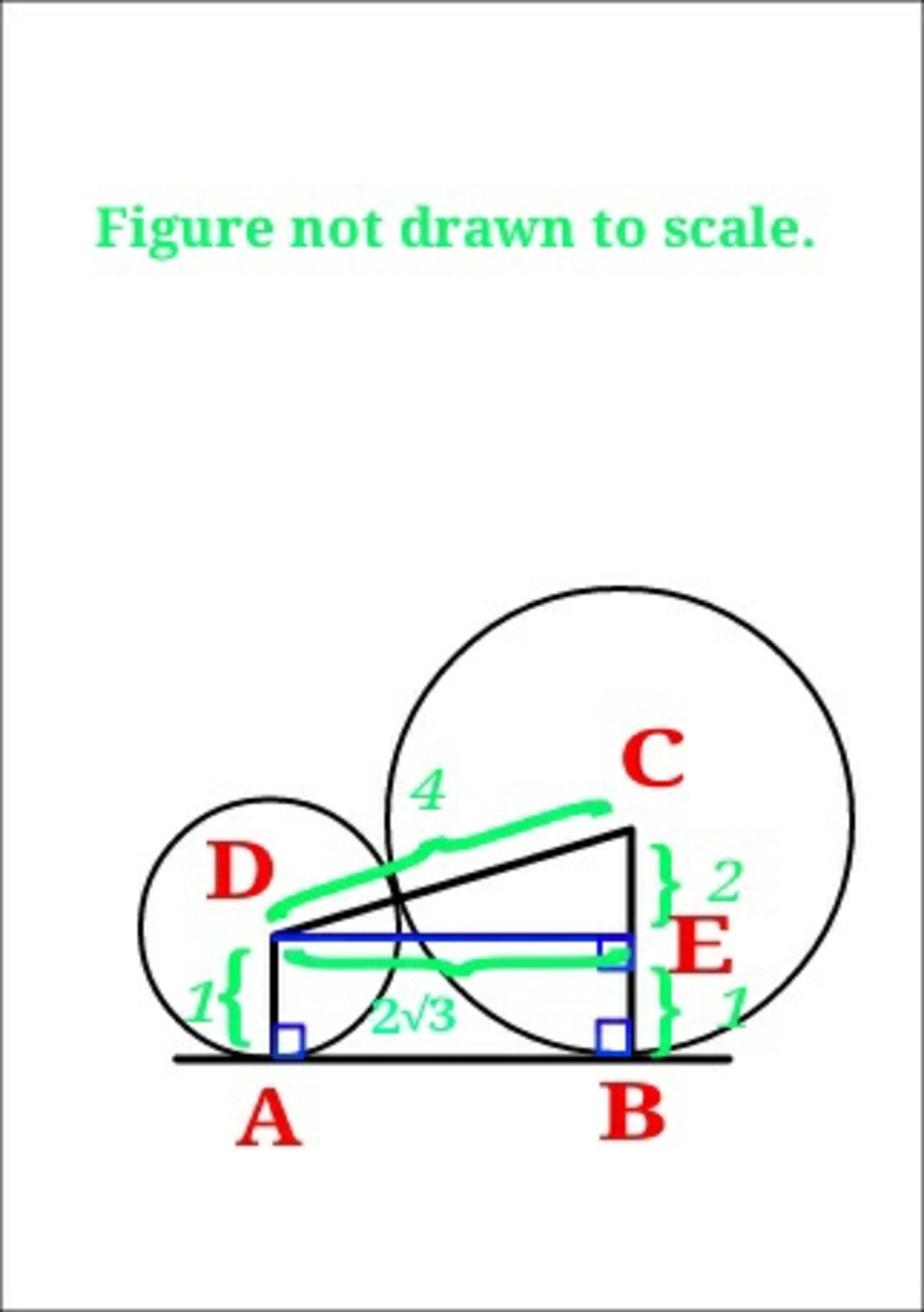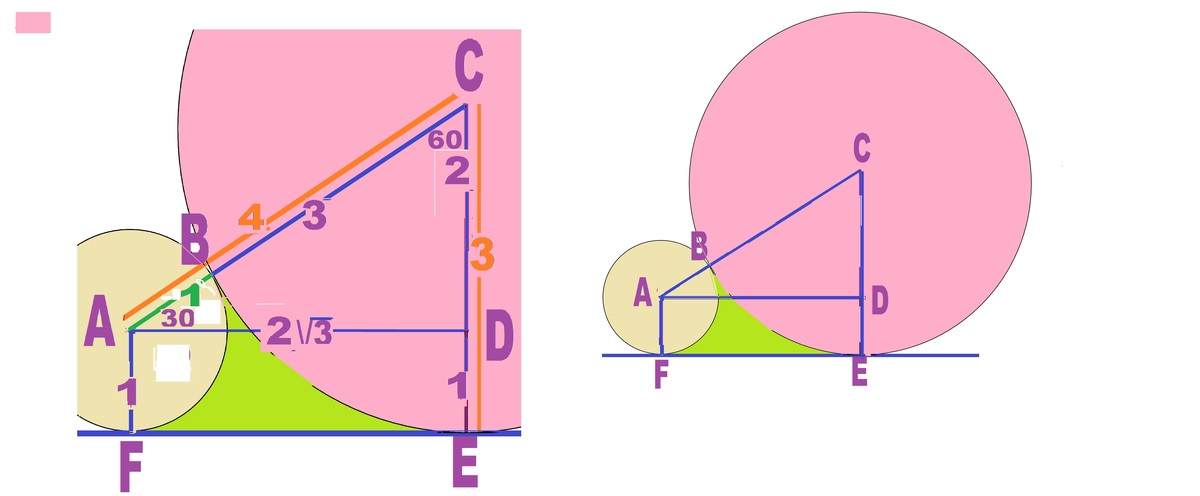Rollin' Stones
Find the area of the hatched region, if the radii of the two circles in the figure above are 1 and 5 1 6 2 + 2 7 5 1 6 2 + 2 7 5 ⋯ .
If your answer is in the form of a b − 2 b c π for some positive pairwise coprime integers a , b , c . Find a + b + c .
The answer is 18.
This section requires Javascript.
You are seeing this because something didn't load right. We suggest you, (a) try
refreshing the page, (b) enabling javascript if it is disabled on your browser and,
finally, (c)
loading the
non-javascript version of this page
. We're sorry about the hassle.
3 solutions
same way. nice solution man.
A nice solution with a beautiful figure (+1)!
First we need to find the radius other than 1 ,
Let,
x = 5 1 6 2 + 2 7 5 1 6 2 + 2 7 5 ⋯
x = 5 1 6 2 + 2 7 x
x 5 − 2 7 x − 1 6 2 = 0
Notice that x = 3 satisfy the above equation (I figured it out by mere hit-n-trial),
Hence the two radii are 1 and 3 .

Clearly,
∠ B C D = 6 0 ° and ∠ A D C = 1 2 0 ° .
a r e a ( A B C D ) = 2 ( 1 + 3 ) 2 3 a r e a ( A B C D ) = 4 3
Now,
R e q . a r e a = a r e a o f A B C D − a r e a o f t w o s e c t o r s
R e q . a r e a = 4 √ 3 − 6 1 . π ( 3 ) 2 − 3 1 . π ( 1 ) 2
R e q . a r e a = 4 √ 3 − 6 1 1 π
Hey. There's an identity that says n ( 1 − a ) x n + a x n − 1 n ( 1 − a ) x n + a x n − 1 n ⋯ = x and in the case of 5 1 6 2 + 2 7 5 1 6 2 + 2 7 5 ⋯ = 3 n = 5 , a = 3 1 , x = 3
Log in to reply
Typo. Not 126 but 162.
Log in to reply
I'm sorry. Thanx for pointing that out. Feelin stupid..
And i failed to indentified that x = 3
need more practice lol
@Digvijay Singh this question is highly overrated according to me! What do you think?
Log in to reply
I Know right? Actually, most of all my questions are overrated. Nothing I can do about that.
And this very question is similar to a question in my IGCSE textbook.. Well in the textbook they just ask for the length AB.
Hey which class do you study Digvijay Singh?
Log in to reply
I'm completing my IGCSE from Cambridge actually... You can call it the '10th'...
Log in to reply
@Digvijay Singh – I know that IGCSE is a very good system but I did not expect it to be this tough! So, you are studying in Cambridge or elsewhere but the syllabus is IGCSE?

R = 5 1 6 2 + 2 7 5 1 6 2 + 2 7 5 . . . ⟹ ( 3 R ) 5 − 3 1 ∗ 3 R − 2 ∗ 3 1 = 0 The equation suggests that R= 3 and indeed, R the radius of big circle is 3. The figure shows the circle BF,r=1, center A, the circle BE,R=3, center C, tangent at B. The straight line is tangent at F and E. Line joining centers, AC = 4. D r a w A D ∣ ∣ E F , D o n C E . C E ⊥ E F = R = 3 , A F ⊥ E F = r = 1 = D E . ∴ C D = 2 . ∴ Δ A C D r t . ∠ e d a t D , 2 C D = A C , t h e h y p o t o n u s . ∴ ∠ = C A D = 3 0 o . A D = 4 ∗ C o s C A D = 2 ∗ 3 . A l s o ∠ B A F = 1 2 0 o , ∠ B C E = 6 0 o . G r e e n a r e a F B E = ( A r e a T r a p e z i u m F B C E ) − ( S e c t o r s 1 2 0 o o f r = 1 a n d 6 0 o o f r = 3 ) = A D ∗ ( 2 1 C D + D E ) − π ∗ ( 1 2 ∗ 3 6 0 1 2 0 + 3 2 ∗ 3 6 0 6 0 ) = 4 ∗ 3 − 6 1 1 ∗ π = 4 ∗ 3 − 2 ∗ 3 1 1 ∗ π R e q u i r e d a + b + c = 1 8 .
Let x= 5 1 6 2 + 2 7 5 1 6 2 + 2 7 5 ⋯ . ⇒ x 5 − 3 3 x − 3 4 × 2 = 0 ⇒ x ( i.e radius of bigger circle ) = 3 R e q u i r e d A r e a ( A ) = a r ( t r a p e z i u m A C D B ) − ( a r ( s e c t o r B E D ) + a r ( s e c t o r A E C ) ) a r ( t r a p e z i u m A C D B ) = 2 1 ( 2 3 ) ( 3 + 1 ) a r ( s e c t o r B E D ) = 2 3 π × 9 a r ( s e c t o r A E C ) = 2 3 2 π × 1 ⇒ A = 4 3 − ( 2 3 π + 3 π ) = 4 3 − 2 × 3 1 1 π Hence, a=4, b=3 and c=11 4 + 3 + 1 1 = 1 8